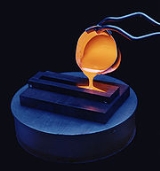
Incandescence
Encyclopedia


Light
Light or visible light is electromagnetic radiation that is visible to the human eye, and is responsible for the sense of sight. Visible light has wavelength in a range from about 380 nanometres to about 740 nm, with a frequency range of about 405 THz to 790 THz...
(visible electromagnetic radiation
Electromagnetic radiation
Electromagnetic radiation is a form of energy that exhibits wave-like behavior as it travels through space...
) from a hot body as a result of its temperature. The term derives from the Latin verb incandescere, to glow white.
The incandescence of a theoretically perfectly black object is known as black body
Black body
A black body is an idealized physical body that absorbs all incident electromagnetic radiation. Because of this perfect absorptivity at all wavelengths, a black body is also the best possible emitter of thermal radiation, which it radiates incandescently in a characteristic, continuous spectrum...
radiation, and its electromagnetic spectrum
Electromagnetic spectrum
The electromagnetic spectrum is the range of all possible frequencies of electromagnetic radiation. The "electromagnetic spectrum" of an object is the characteristic distribution of electromagnetic radiation emitted or absorbed by that particular object....
is described by Planck's law. The total power emitted by radiation from a black body is given by the Stefan–Boltzmann law. Wien's displacement law
Wien's displacement law
Wien's displacement law states that the wavelength distribution of thermal radiation from a black body at any temperature has essentially the same shape as the distribution at any other temperature, except that each wavelength is displaced on the graph...
predicts the wavelength of peak emission.
Observation and use
In practice, virtually all solid or liquid substances start to glow around 798K (525°C), with a very dull red color, when no chemical reactions take place that produce light as a result of an exothermic process. This limit is called Draper pointDraper point
The Draper point is the approximate temperature above which almost all solid materials visibly glow as a result of blackbody radiation. It was established at 977˚ F by John William Draper in 1847....
. The incandescence does not vanish below that temperature, but it is too weak in the visible spectrum to be perceivable.
Incandescence is exploited in incandescent light bulb
Incandescent light bulb
The incandescent light bulb, incandescent lamp or incandescent light globe makes light by heating a metal filament wire to a high temperature until it glows. The hot filament is protected from air by a glass bulb that is filled with inert gas or evacuated. In a halogen lamp, a chemical process...
s, in which a filament is heated to a temperature at which a fraction of the radiation falls in the visible spectrum. The majority of the radiation however, is emitted in the infrared part of the spectrum, rendering incandescent lights relatively inefficient as a light source.
Fluorescent lamp
Fluorescent lamp
A fluorescent lamp or fluorescent tube is a gas-discharge lamp that uses electricity to excite mercury vapor. The excited mercury atoms produce short-wave ultraviolet light that then causes a phosphor to fluoresce, producing visible light. A fluorescent lamp converts electrical power into useful...
s do not function by incandescence, rather by a combination of thermionic emission
Thermionic emission
Thermionic emission is the heat-induced flow of charge carriers from a surface or over a potential-energy barrier. This occurs because the thermal energy given to the carrier overcomes the binding potential, also known as work function of the metal. The charge carriers can be electrons or ions, and...
and atomic excitation
Excited state
Excitation is an elevation in energy level above an arbitrary baseline energy state. In physics there is a specific technical definition for energy level which is often associated with an atom being excited to an excited state....
caused by collision with high energy electrons. In an incandescent lamp, only the electrons at the top of the band can participate. While higher temperatures can increase efficiency, there are currently no materials able to withstand such temperatures which would be appropriate for use in lamps.

